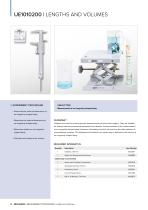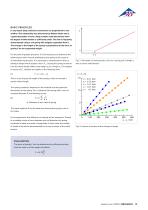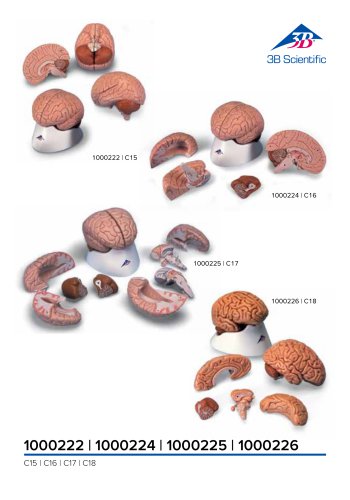 Website:
3B Scientific
Website:
3B Scientific
Group: 3B Scientific
Catalog excerpts

PHYSICS & ENGINEERING EXPERIMENTS Mechanics | Heat | Electricity | Optics | Atomic & Modern Physics I Bio- & Medical Physics Find all experiments and products online at 3bscientific.com
Open the catalog to page 1
DEAR VALUED CUSTOMER, The revised Physics and Engineering Experiment catalog now contains more than 135 experiments for the modern Physics laboratory. This straightforward collection covers the whole spectrum of Physics, from classical to modern. Each experiment includes: • Objectives • Easy to follow illustration of the experimental set-up • Introduction of the theoretical and experimental background • Summary of expected experiment results • Detailed list of required equipment Our web site www.3bscientific.com provides you detailed information and full product specifications. Many of the...
Open the catalog to page 2
EXPERIMENT MAXWELL’S WHEEL with new data logger WiLab, works with Chromebooks, iPads, Android tablets, and with Mac and Windows computers NEW EXPERIMENT ZEEMAN EFFECT PAGE 244 NEW EXPERIMENT DOPPLER SONOGRAPHY PAGE 276
Open the catalog to page 3
Wavelength and Speed of Sound Mechanics of Liquids and Gases DC and AC Circuits Charging and Discharging a Capacitor I... 146 Charging and Discharging a Capacitor II ..148
Open the catalog to page 4
ATOMIC AND NUCLEAR PHYSICS Introductory Experiments in Atomic SOLID-STATE PHYSICS X-RAY PHYSICS STUDENT EXPERIMENTS
Open the catalog to page 5
OBJECTIVE Determine the radius of curvature of various watch glasses SUMMARY From the height h of a spherical surface above a point on a plane defined by the corners of an equilateral triangle, the radius of curvature R of the spherical surface may be determined. This can be done for both convex and concave curvatures of the sphere. > EXPERIMENT PROCEDURE • Measure the height of the curvature h for two watch glasses for a given distance s between the tips of the spherometer legs. • Determine the radius of curvature R of both glasses. • Compare the methods for both convex and concave...
Open the catalog to page 6
BASIC PRINCIPLES A spherometer consists of a tripod with the three legs tipped by steel points and forming an equilateral triangle with sides of 50 mm. A micrometer screw, the tip of which is the point to be measured, passes through the center of the tripod. A vertical rule indicates the height h of the measured point above a plane defined by the tips of the three legs. The height of the measured point can be read off to an accuracy of 1 pm with the aid of a circular scale that rotates along with the micrometer screw. The relationship between the distance r of all three legs from the center...
Open the catalog to page 7
OBJECTIVE Measurement of an irregularly shaped body > EXPERIMENT PROCEDURE • Determine the external dimensions of an irregularly shaped body. • Determine the internal dimensions of SUMMARY an irregularly shaped body. Callipers are used for making precise measurements of quite short lengths. They are suitable for finding internal and external dimensions and depths, as demonstrated in the measurement • Determine depths on an irregularly of an irregularly shaped body. However, calculating a body's volume from the data obtained is shaped body. comparatively complex. The displacement method is...
Open the catalog to page 8
BASIC PRINCIPLES One suitable method for determining the volume of an irregularly shaped body is the overflow method. This involves immersing the body in water inside a vessel with an overflow outlet. The water displaced by the body is then collected in a graduated measuring cylinder. The volume of water displaced is equal to the volume V of the body. In order to avoid systematic errors, callipers must wherever possible be used in such a way that they are not tilted. The accuracy is conventionally increased to resolve fractions of a millimeter by the inclusion of a vernier scale. The full...
Open the catalog to page 9
> EXPERIMENT PROCEDURE OBJECTIVE Measure the gravitational force and determine the gravitational constant using • Determine the initial equilibrium posi- Cavendish torsion balance tion of the torsional pendulum. • Record the oscillation of the torsional pendulum about the final equilibrium position and determine the period. • Determine where the final equilibrium position is. • Calculate the gravitational constant G. SUMMARY The central component of a Cavendish torsion balance is a sensitive torsional pendulum with a pair of small lead spheres attached to it. Two larger lead spheres are...
Open the catalog to page 10
The central component of a Cavendish torsion balance is a sensitive torsional pendulum with a pair of small lead spheres attached to it. Two larger lead spheres are then placed near these two small balls in order to attract them. The position of the large spheres thus determines the equilibrium position of the torsional pendulum. If the two large spheres are then moved to a second position which is symmetrical with the first with respect to the two small balls, the torsional pendulum will adopt a new equilibrium position after a short period of settling. By measuring the geometry of the...
Open the catalog to page 11
OBJECTIVE Confirm Hooke’s law for coil springs under tension In any elastic body, extension and tension are proportional to one another. This relationship was • Confirm Hooke's law and determine discovered by Robert Hooke and is frequently demonstrated using a coil spring with weights the spring constant of five different suspended from it. The change in the length of the spring is proportional to the force of grav- coil springs. ity F on the suspended weight. In this experiment, five different coil springs will be measured. Thanks to a suitable choice of wire diameter and coil diameter,...
Open the catalog to page 12
BASIC PRINCIPLES In any elastic body, extension and tension are proportional to one another. This relationship was discovered by Robert Hooke and is a good description of how a large number materials behave when the degree of deformation is sufficiently small. This law is frequently demonstrated using a coil spring with weights suspended from it. The change in the length of the spring is proportional to the force of gravity F on the suspended weight. For the sake of greater precision, it is first necessary to determine the initial tension which may be exhibited by the spring as the result...
Open the catalog to page 13All 3B Scientific catalogs and technical brochures
-
Atlas Product Manual
18 Pages
-
Cardionics Brochure Simulation
23 Pages
-
Acupuncture
35 Pages
-
Best of Therapy
12 Pages
-
Manual P120/P121/P122/P124/P125
60 Pages
-
Medical Simulation EMS TCCC
9 Pages
-
MEDICAL SIMULATION
35 Pages
-
Catalog Natural Sciences
196 Pages
-
L50, L51, L55
36 Pages
-
P80 SIMone Product Manual
52 Pages
-
N30 / N31 Product Manual
12 Pages
-
P10/1,P11/1 product manual
11 Pages
-
P10CCD product manual
16 Pages
-
P10CCD product brochure
2 Pages
-
P72+light Product manual
28 Pages
-
P72+light Product brochure
2 Pages
-
P16 Product manual
8 Pages
-
P16 Product brochure
2 Pages
-
Female Breast
30 Pages
-
C41
16 Pages
-
C18
9 Pages
-
G01
24 Pages
-
3B Smart Anatomy
3 Pages
-
M10
16 Pages
-
A291
20 Pages
-
F11
13 Pages
-
P72
48 Pages
-
B60
16 Pages
-
A05/2 ,A11, A13
18 Pages
-
A290 A291
20 Pages
-
G21, G22
9 Pages
-
K25
12 Pages
-
K20, K21
12 Pages
-
K17
16 Pages
-
D25 Half Lower Jaw
13 Pages
-
D20 Dentition Development
12 Pages
-
D10
12 Pages
-
L56
30 Pages
-
C15, C16, C17, C18, C20
12 Pages
-
P57 Quick instructions
16 Pages
-
N15 Acupuncture Ears
2 Pages










![Product Manual - I.v. Injection Arm P50/1 - P50/1 [1021418]](https://img.medicalexpo.com/pdf/repository_me/67454/product-manual-iv-injection-arm-p50-1-p50-1-1021418-249392_1mg.jpg)


![Product Manual - Hemorrhage Control Arm Trainer P102 - P102 [1022652]](https://img.medicalexpo.com/pdf/repository_me/67454/product-manual-hemorrhage-control-arm-trainer-p102-p102-1022652-249356_1mg.jpg)
![Product Manual - Trainer for wound care and bandaging techniques - P100 [1020592]](https://img.medicalexpo.com/pdf/repository_me/67454/product-manual-trainer-wound-care-bandaging-techniques-p100-1020592-249350_1mg.jpg)
![Product Manual - Postpartum Hemorrhage Trainer - PPH Trainer P97 - P97 [1021568]](https://img.medicalexpo.com/pdf/repository_me/67454/product-manual-postpartum-hemorrhage-trainer-pph-trainer-p97-p97-1021568-249337_1mg.jpg)















































